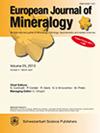Monte Avic超镁铁岩中以PS-15型多角蛇纹石为主的晚变质脉
IF 1.7
3区 地球科学
Q2 MINERALOGY
引用次数: 0
摘要
摘要Monte Avic(意大利西阿尔卑斯山脉奥斯塔山谷)的超镁铁质岩体由反长辉长岩蛇纹岩和钛斜辉长岩变长岩组成。它们拥有晚变质脉,厚达几厘米,致密,均匀,具有“瓷器”外观。静脉的颜色从淡黄色到淡绿色,淡黄色逐渐变白,或罕见的橙色。矿脉由15段PS-15多边形蛇纹石组成,化学成分为Mg2.85 Fe0.08 Si2.05 O7.05[OH]3.95。通过x射线粉末衍射模式(例如,2.502,2.336,2.151和1.966 Å)的诊断卫星反射,TEM图像(显示15扇形纤维,大部分直径为200 nm,长度为几微米,形成随机定向毡)和μ拉曼波数,与先前的数据相匹配,支持了这种不寻常相位的识别。这种不同的证据提供了PS-15和PS-30的成功区分,或者使用TEM图像,x射线粉末衍射,或低波数和高波数μ拉曼光谱。在MonteAvic,矿脉侵位伴随着明显的流体压力,这表明寄主岩石的变形和肢解作用,PS-15在各向同性应力微环境中发育,其特征是充满流体的空洞。低应变条件有利于质量纤维多边形蛇纹石的随机生长。PS-15脉形成于长多相高山造山带演化末期,含水流体可能来源于深部蛇纹岩脱水。本文章由计算机程序翻译,如有差异,请以英文原文为准。
Late metamorphic veins with dominant PS-15 polygonal serpentine in the Monte Avic ultramafite
Abstract. The ultramafic body of Monte Avic (Aosta Valley, Western Alps,
Italy) consists of antigorite serpentinite and Ti-clinohumite metadunite.
They host late metamorphic veins, up to a couple of centimeters thick,
compact, and homogeneous, with a “porcelain” appearance. Vein colors range
from yellowish to light greenish, light yellowish fading to white, or rare
orange. The veins consist of 15-sector PS-15 polygonal serpentine,
with chemical composition Mg2.85 Fe0.08 Si2.05 O7.05
[OH]3.95. Recognition of this unusual phase is supported by diagnostic
satellite reflections in the X-ray powder diffraction pattern (e.g., at
dobs of 2.502, 2.336, 2.151, and 1.966 Å) TEM images (showing
15-sector polygonal fibers, mostly 200 nm in diameter and a few µm in
length, forming a randomly oriented felt) and a µ-Raman wavenumber,
matching previous data. This different evidence affords the successful
distinction of PS-15 and PS-30, alternatively using TEM images, X-ray powder
diffraction, or the low- and high-wavenumber µ-Raman spectra. At Monte
Avic, the vein emplacement was accompanied by significant fluid pressure, as
suggested by deformation and dismembering of the host rock, with PS-15 grown
within isotropic stress microenvironments characterized by fluid-filled
voids. Random growth of the mass-fiber polygonal serpentine was favored by
low-strain conditions. PS-15 veins formed at the end of the long polyphase
Alpine orogenic evolution, with hydrous fluids possibly deriving from
serpentinite dehydration in the depth.
求助全文
通过发布文献求助,成功后即可免费获取论文全文。
去求助
来源期刊
CiteScore
2.80
自引率
9.50%
发文量
40
审稿时长
6-12 weeks
期刊介绍:
EJM was founded to reach a large audience on an international scale and also for achieving closer cooperation of European countries in the publication of scientific results. The founding societies have set themselves the task of publishing a journal of the highest standard open to all scientists performing mineralogical research in the widest sense of the term, all over the world. Contributions will therefore be published primarily in English.
EJM publishes original papers, review articles and letters dealing with the mineralogical sciences s.l., primarily mineralogy, petrology, geochemistry, crystallography and ore deposits, but also biomineralogy, environmental, applied and technical mineralogy. Nevertheless, papers in any related field, including cultural heritage, will be considered.

 求助内容:
求助内容: 应助结果提醒方式:
应助结果提醒方式:


